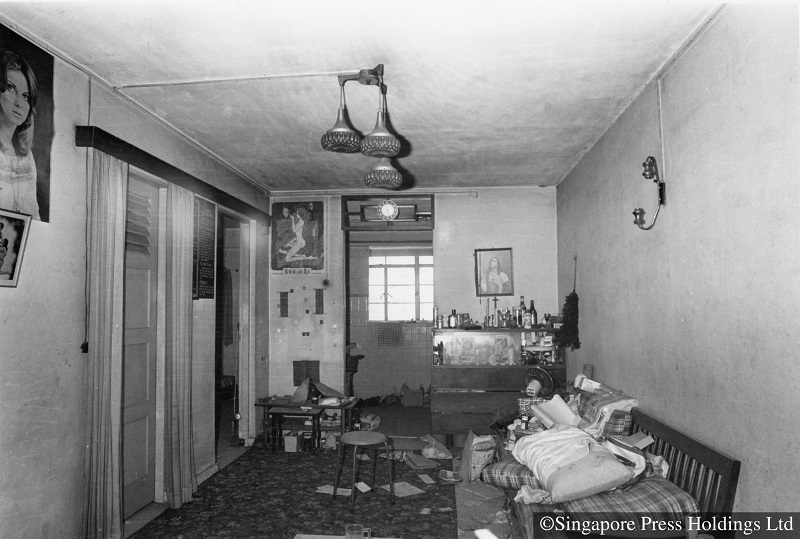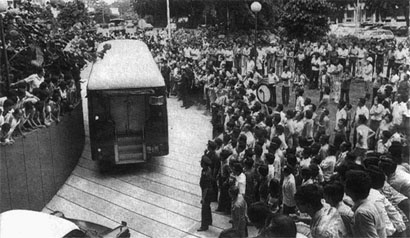THE TOA PAYOH RITUAL MURDERS: A CASE OF INSANITY OR WAS IT JUST A “WAYANG”? (PART 1)
Much has been written about one of Singapore’s most sensational crimes which took place 40 years ago. Delving into unpublished oral history accounts collected under SAL’s legal Heritage Programme and the National Archives of Singapore, we revisit the trial which continues to intrigue long after the case was closed.

BY FOO KIM LENG
In early 1981, two children were killed in the vicinity of Toa Payoh. Shortly after, police investigators found a trail of blood leading to Block 12, Lorong 7, where Adrian Lim, his wife Catherine Tan Mui Choo and mistress Hoe Kah Hong were living on the 7th floor. They were arrested and charged with the murder of nine-year-old Agnes Ng Siew Heok and ten-year-old Ghazali bin Marzuki.
The gruesome murder had started to attract huge public attention. Justice Choo Han Teck who was then an associate at Murphy & Dunbar had a foretaste of this when he saw large crowds trying to catch a glimpse of Adrian Lim when the trio were charged in the former Subordinate Courts. Justice Choo remarked to his then boss Howard Cashin that he would feel sorry for the defence lawyers.
Not long after, Howard Cashin received a call from the Registrar of the Supreme Court to inform that he has been assigned to defend Adrian Lim. Choo Han Teck was to assist and the Registrar agreed to appoint both of them as counsel. Recalling this, Justice Choo said, “I believe that was the very first case in which the Supreme Court had appointed two counsel for an accused of a capital case.” J B Jeyaretnam acted for Catherine Tan Mui Choo and Nathan Isaac was assigned to defend Hoe Kah Hong.
Capital cases in the 1980s were presided by two judges. Justice T S Sinnathuray recalled that whenever he sat at criminal cases with Justice F A Chua, “I always said he should preside… You are still the senior judge,” even though F A Chua had retired and was re-employed on an extended term. This happened until “the notorious Adrian Lim case. Freddy said, ‘No, you should preside.’”
The court was set for one of the longest and most sensational trials in Singapore’s legal history. In his oral history account, Justice Sinnathuray felt that the “undue publicity” and time taken over the trial was “unnecessary.”
“So far as the defence was concerned, they were not disputing the facts of the murder. The only defence they put forward was one of diminished responsibility. Therefore, it was not necessary for the prosecution to go through the case and gazette it as a contested case. But that is not how the trial went.
“Glenn Knight took upon himself to cross-examine the accused persons at great length and as trial judges, both Freddy and I kept telling him, ‘Look, this was not in dispute. Get on with the case.’ And the case went on unnecessarily long. You couldn’t interrupt it too much you see. After all, it is a sensational murder case and… people were queuing up to get into the public gallery.
“So the judges’ hands were tied to some extent. All we could do was just sort of request counsel to get on with the case and eventually the main evidence was psychiatric evidence. That I can understand would have taken a lot of time and they did.”

Justice Choo recalled spending long periods with psychiatrist Dr Wong Yip Chong, who was the defence’s star witness. To assist Dr Wong, Justice Choo would make frequent trips from his office at Raffles Place to the Queenstown Remand Prison to speak with Adrian. “In those days, I could sit just opposite him without any barricade between us and, of course, when you’ve spent so much time with a person, he is more open to the interviewer. My impression of him then was that he was quite frank with me. He wasn’t trying to put up a show, not for me, but even then, he was not entirely rational.”
“It was painstaking, thorough work,” recalled Dr Wong. Adrian Lim’s submission was one of the longest that he had seen. “[It] came in pages and pages. It’s typical for a manic to be expansive and go into great details.” He remembered that the cross-examination by the DPP was “ferocious”. “In the court of law, you are literally naked… you say something stupid… you use the wrong word, either you apologise or you stick to your guns [and] get yourself in a further mess. That to me is very, very exciting… there is no place for dishonesty… because in a cross-examination, you got to be asked everything… they look and take notes.”
“Dr Wong Yip Chong… could answer the questions exceptionally well. And if you asked him a question that was his area, you would be in trouble. And he would pick on it and he would twist you around it,” recalled Glenn Knight on how challenging it was to cross-examine the medical experts. Besides Dr Wong, the prosecution also had to contend with Dr R Nagulendran, another psychiatrist in private practice who gave evidence for the two women.
“Dr Nagulendran was absolutely solid. He would answer questions beautifully and he would know his books standing on his head. When we tried to cross-examine him, after a while he said, ‘You are for me or you are for the other side?’” Writing about the trial in his book, The Prosecutor, Glenn Knight recalled spending more than 72 hours researching various mental illnesses. The 41-day trial left him totally exhausted.
But one of his biggest opposition came not from arguments in the court room but from his wife. “My wife always told me that you don’t get these two girls convicted. I said, ‘What do you mean? They deserve to hang.’ And she said, ‘They are okay you know.’ So I had to fight my wife and I knew that I had to really make sure that they are caught…”
“I thought they were just taking everybody for a ride. They were pretending to be in this game… and they were just bad people, nothing more to it.” There was no question in his mind that the three accused were the most evil persons that he had to prosecute. The accounts of blood drinking were “part of the wayang … As far as I am concerned, they deserve to die and even when I had to put up their case for clemency, I couldn’t consider it as being a fair chance that they would get away with it. They just did something wrong and that was all there was to it.”
“I had the major task of showing the court that Adrian really was not sane. And I must confess I really didn’t think he was sane,” recalled Howard Cashin. “Glenn Knight has since told me that we made such a stand over this sanity business that he became very worried indeed. I don’t think Judge Sinnathuray accepted much of it although I think the other judge… Freddy Chua, I felt at least I got him partially on my side.”
“I still to this day think that he’s a manic,” recalled Dr Wong in his interview with the National Archives in 1998. This came across at his first meeting with Adrian. “He was very grandiose. He [told me], ‘Oh, don’t mind Dr Wong. I’ll be alright. I’ve got gods behind me.’ We have somebody who is very cocksure of himself. Right away you can see there is a grandiosity which is a feature of manic illness.”
Justice Choo who spent a long time with Adrian was also convinced that he was not of sound mind. “…the more I worked with him, the more convinced I was that this man was not normal, the more convinced I was that he couldn’t personally be responsible for the action the way we would be responsible for ours… half the time he was probably not telling the truth. But the sense I had was not that he deliberately wanted to lie but I think he just couldn’t help himself. He was just concocting story after story as they came to his mind. So he has never got a single consistent story throughout.”
THE VERDICT
On 25 May 1983, Justice Sinnathuray delivered the verdict which took 15 minutes. “At the end of the day, we had no difficulty. Overnight after the submissions were over, we drafted a very short judgment. I wrote it and Freddy agreed with me. We found the accused guilty and we rejected the defence of diminished responsibility and that was the end of that. And I remember the press made some comments about a trial that lasted so very long and the judgments were very, very short… it was a straight forward case.”
Could it have gone another way? In Part 2 of our article, we explore the reactions of the defence to Justice Sinnathuray’s verdict, the impact of public opinion on the trial and the Adrian Lim’s last days at death row.
The oral history interviews referenced above are part of The Development of The Singapore Legal System, a joint oral history programme by SAL’s Legal Heritage Committee and the Oral History Centre, National Archives of Singapore. Listen to:
· Justice Sinnathuray’s interview
· Mr Howard Cashin’s interview
Justice Choo Han Teck’s oral history interview will be released at a later date.






